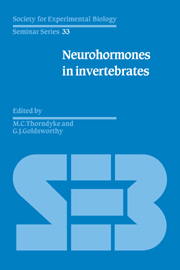Book contents
- Frontmatter
- Contents
- List of contributors
- Preface
- What is special about peptides as neuronal messengers?
- Part I Immunocytochemistry and Ultrastructure
- Part II Arthropod Neurohormones
- Characterization of insect neuropeptides
- The isolation and characterisation of vertebrate-type peptides in insects
- Humoral functions of insect neuropeptides
- Functions of aminergic and peptidergic skeletal motoneurones in insects
- Physiology and biochemistry of crustacean neurohormonal peptides
- Part III Neurohormones in Coelenterates, Annelids and Protochordates
- Part IV Neurohormones in Molluscs
- Index
Functions of aminergic and peptidergic skeletal motoneurones in insects
Published online by Cambridge University Press: 04 August 2010
- Frontmatter
- Contents
- List of contributors
- Preface
- What is special about peptides as neuronal messengers?
- Part I Immunocytochemistry and Ultrastructure
- Part II Arthropod Neurohormones
- Characterization of insect neuropeptides
- The isolation and characterisation of vertebrate-type peptides in insects
- Humoral functions of insect neuropeptides
- Functions of aminergic and peptidergic skeletal motoneurones in insects
- Physiology and biochemistry of crustacean neurohormonal peptides
- Part III Neurohormones in Coelenterates, Annelids and Protochordates
- Part IV Neurohormones in Molluscs
- Index
Summary
Introduction: identifiable insect skeletal mononeurones and why they are important
Insect skeletal muscle is innervated by monopolar motoneurones in the segmental ganglia of the CNS which send motor axons to specific muscle targets. The specificity of muscle innervation allows us to identify motoneurones uniquely by their target muscles. Motoneurones innervating particular muscles have a characteristic position and morphology in the central nervous system, and these characteristics can also be used to identify them. An example is provided by the slow coxal depressor or Ds motoneurone of the cockroach Periplaneta americana. This neurone, as its name suggests, innvervates coxal depressor muscles and it has an invariant position and morphology. It is one of perhaps 5 motoneurones involved in the innervation of the coxal depressors. In addition to being identifiable, skeletal motoneurones innervating particular muscles in insects are few in number (in contrast to vertebrate muscle innervation for example). Thus the large extensor muscle of the locust tibia, the extensor tibialis muscle, is innervated by only 4 motor cells, each of which has been identified (see below). The identifiability of insect motorneurones and their small number have combined to make insect neuromuscular systems important model preparations.
The simplicity of insect neuromuscular systems has obvious advantages for the study of muscle physiology in these organisms. Insect motor neurones differ from the classical vertebrate model by using multiple transmitters. This feature has allowed us to study fundamental aspects of synaptic physiology, pharmacology and neuronal function which perhaps could not be studied as conveniently in other organisms.
- Type
- Chapter
- Information
- Neurohormones in Invertebrates , pp. 159 - 172Publisher: Cambridge University PressPrint publication year: 1988
- 3
- Cited by



